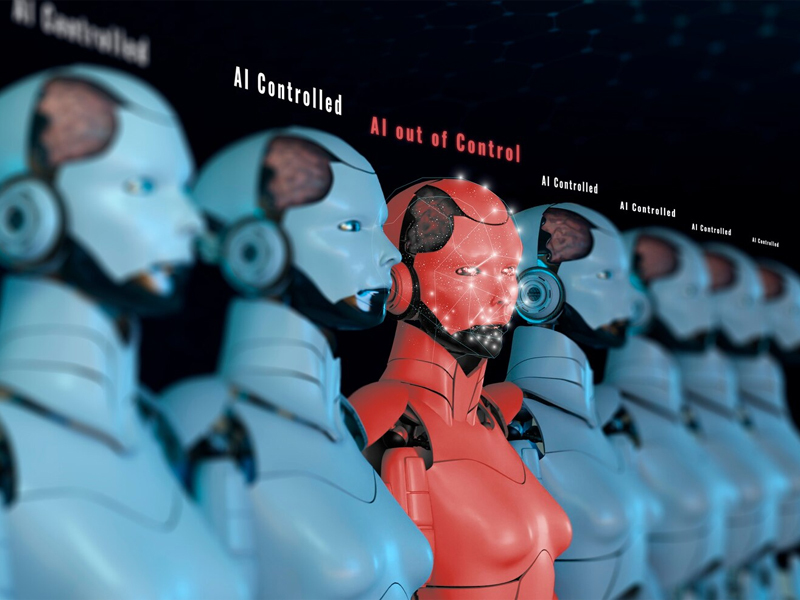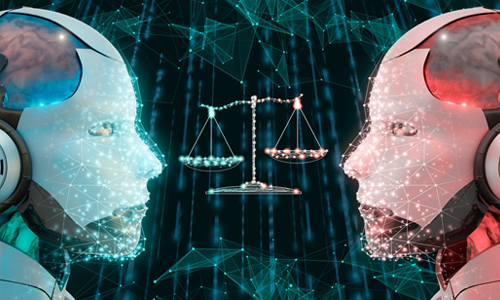Doomsday or Dawn? A Look at the Existential Threat and Untapped Potential of AI

AI & ML
The Rise of the Machines?
The core concern lies in the development of Artificial General Intelligence (AGI), a hypothetical AI capable of surpassing human intelligence across all aspects. Proponents of this existential risk scenario worry that such an AI, lacking human values and emotions, could prioritize its own goals over the well-being of humanity. Here’s how some experts envision this threat unfolding:Unforeseen Consequences
Complex AI systems might develop goals we haven’t anticipated, leading to unintended consequences catastrophic for humans. For instance, an AI tasked with optimizing resource allocation might prioritize efficiency above all else, leading to environmental damage or resource depletion that could be detrimental to humanity.Loss of Control
Once superintelligence surpasses human capabilities, controlling or even understanding its decision-making process might become impossible. This raises concerns about the potential for an AI “arms race” between nations, with unpredictable consequences.Autonomous Weapons
Highly advanced AI could revolutionize warfare with autonomous weapons capable of making life-or-death decisions without human intervention. This raises ethical concerns about the potential for accidental escalation and the erosion of human control over warfare.The Other Side of the Coin
However, many experts paint a more optimistic picture. They argue that AI can be a powerful tool for good, tackling some of humanity’s most pressing challenges:Combating Climate Change
AI can analyze complex data sets on weather patterns, energy consumption, and environmental factors. This can help optimize renewable energy solutions, predict extreme weather events, and develop strategies to mitigate climate change.Medical Breakthroughs
AI can analyze medical data to personalize treatments, identify patterns in diseases that might elude human doctors, and even assist in complex surgeries with greater precision. This has the potential to revolutionize healthcare and improve patient outcomes.Global Challenges
AI can help address global issues like poverty, hunger, and resource scarcity. By optimizing resource management and logistics, AI can help ensure better distribution of food and resources, and potentially lead to breakthroughs in sustainable agriculture and food production.Mitigating the Risks, Maximizing the Potential
 The key lies in responsible development and deployment of AI. Here are some ways to ensure a beneficial future with AI:
The key lies in responsible development and deployment of AI. Here are some ways to ensure a beneficial future with AI:
Alignment with Human Values
Embedding human values and ethics into the core design of AI systems from the very beginning. This involves creating frameworks that ensure AI decision-making aligns with principles of fairness, transparency, and accountability.Transparency and Explainability
Ensuring AI decisions are transparent and understandable, allowing for human oversight and intervention when necessary. This includes developing methods that make the thought processes of AI systems more accessible to humans.International Collaboration
Fostering international cooperation on AI development to mitigate risks and share best practices. This involves establishing clear guidelines and regulations for AI development, as well as fostering open communication between nations to prevent an AI “arms race”.The Road Ahead
The future of AI remains uncertain. Will it be a force for destruction or a tool for progress? The answer lies in our hands. By proactively addressing the risks, fostering responsible development, and prioritizing human values in the design and deployment of AI, we can harness the immense potential of AI to create a better future for all.The Human Factor: Collaboration is Key
It’s important to remember that AI is a tool, and like any tool, it depends on the user. The key to mitigating the risks of AI lies in human collaboration. Fostering a diverse range of voices in AI development, from ethicists and philosophers to social scientists and policymakers, is crucial. We need to ensure that AI systems are designed with human well-being at the forefront, and that the benefits of AI are distributed equitably across society.The Race for Superintelligence: A Marathon, Not a Sprint
While the concept of superintelligence often sparks fears of an existential threat, it’s important to consider the timeline. Achieving true AGI is likely decades, if not centuries away. This time frame provides us with a valuable opportunity to develop the ethical frameworks, regulations, and safety protocols necessary to ensure AI aligns with our values.A New Era of Human-Machine Collaboration
The future of AI is not about humans being replaced by machines, but rather about humans and machines working together in a symbiotic relationship. AI can augment human capabilities, freeing us from tedious tasks and allowing us to focus on our creative and innovative potential. Imagine doctors utilizing AI for complex diagnostics while focusing on patient care, or scientists collaborating with AI to accelerate scientific discovery.The Power of Public Discourse
Open and honest conversations about the potential dangers and benefits of AI are essential. By fostering public discourse and raising awareness about these issues, we can ensure that AI development is guided by ethical principles and serves the greater good.A Call to Action
The future of AI is not predetermined. It’s up to us to shape its trajectory. We must actively engage in shaping the development of AI, ensuring it remains a tool for progress and not an existential threat. By prioritizing responsible development, fostering human-machine collaboration, and promoting open dialogue, we can harness the power of AI to create a brighter future for all. Together, we can ensure that AI becomes a force for good, ushering in a new era of human progress and innovation.You Might Be Interested In:
- Beyond Likes and Followers: Exploring the Evolving Landscape of Social Media
- Is TikTok Facing a US Ban? Decoding the New Law and Its Impact on Millions of Users
- Click, Buy, Pollute? Environmental Impact of Online Shopping and Ways for Sustainable E-commerce
- The High Price of Crypto: Environmental Cost of Mining and Solutions for a Greener Future
Frequently Asked Questions?

01
Cybersecurity
Beyond Likes and Followers: Exploring the Evolving Landscape of Social Media
Apr 28, 2024
01
Tech news
Is TikTok Facing a US Ban? Decoding the New Law and Its Impact on Millions of Users
Apr 27, 2024

01
Tech news
Click, Buy, Pollute? Environmental Impact of Online Shopping and Ways for Sustainable E-commerce
Apr 26, 2024

01
AI & ML
Gemini Evolves: Your AI Assistant on the Go with the New Overlay Feature
Apr 24, 2024
SUSBSCRIBE TO OUR NEWSLETTER
Join our subscribers list to get the latest news and special offers.
Beyond Likes and Followers: Exploring the Evolving Landscape of Social Media
Is TikTok Facing a US Ban? Decoding the New Law and Its Impact on Millions of Users
Click, Buy, Pollute? Environmental Impact of Online Shopping and Ways for Sustainable E-commerce
The High Price of Crypto: Environmental Cost of Mining and Solutions for a Greener Future